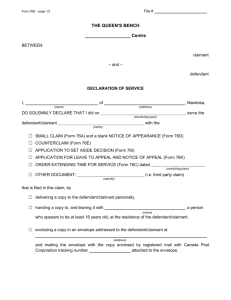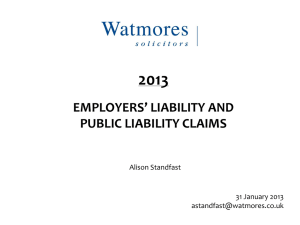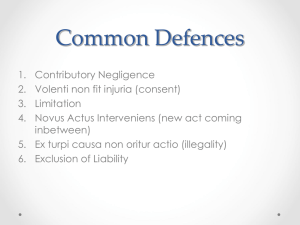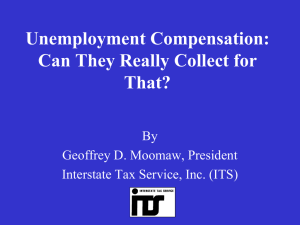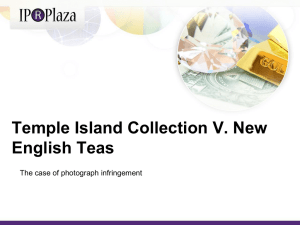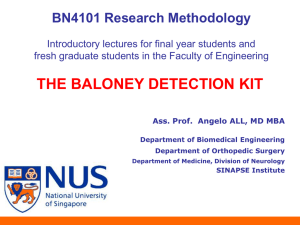What is a catastrophic injury claim?
advertisement
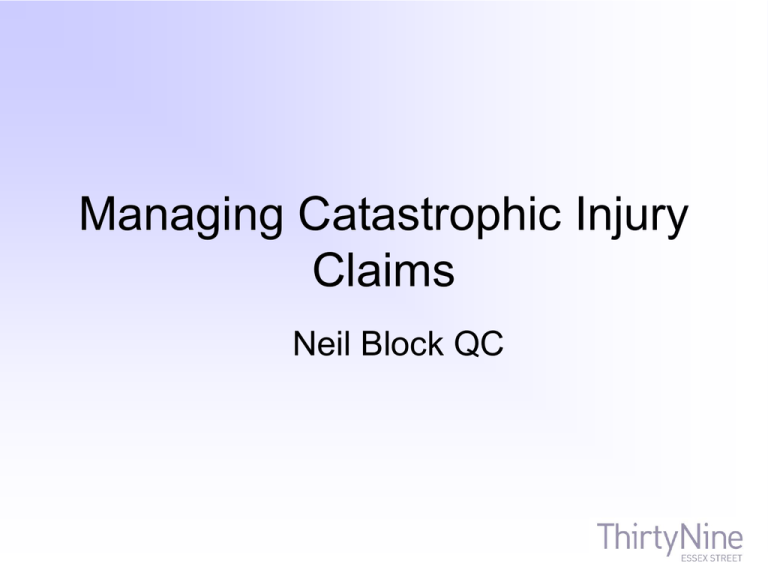
Managing Catastrophic Injury Claims Neil Block QC Catastrophic Injury Claims What is a catastrophic injury claim? • Injury v Quantum • Brain/spinal/other serious injuries e.g. amputations, burns, internal organs. • Proportionality Hospitalisation period • Immediately investigate liability • Modest interim payment to alleviate family financial concerns – may be problems if primary liability seriously in issue • Consider suitability of pre-accident home for C and for carers etc. • Liaise with PCT and LA to ascertain necessary steps to obtain funding/services/equipment • Identify and appoint Case Manager to advise and assist with discharge arrangements – liaise with D about appointment • Consider engaging an expert (possibly jointly) to assist with obtaining funding for carers on discharge Rehabilitation Aims: • To maximise level of recovery – C will/ought to desire this over maximising compensation. D will also desire this – humanity and commercially • To assist C to live independently and/or with lesser care/housing/therapy/equipment etc. needs. • Vocational – to assist C return to work, consider other options, retrain • To provide better information about condition and prognosis – may remove uncertainty about prospects of recovery. • Evidence is that early rehabilitation produces best results Rehabilitation Code • Introduced 1999 – promotes “the use of rehabilitation and early intervention in the claims process so that the injured person makes the best and quickest possible medical, social and psychological recovery.” • Set out in Facts & Figures • Optional. Compatible with but does not relieve obligations under CPR Pre-action Personal Injury Protocol • C’s solicitor has a duty to discuss C’s needs at the earliest possible stage with a view to putting rehabilitation proposals to D/insurer. To be done before any medical evidence has been commissioned. • D/insurer has a duty to consider whether C will benefit from rehabilitation and to communicate this to C’s solicitor. Any proposals made by D/insurer must be discussed by C’s solicitor with C and appropriate advice must be sought from the treating doctors. • Unless the rehabilitation needs have been identified and agreed there should be an independent needs assessment The Independent Needs Assessment (“INA”) • • • • • • • Must be carried out by one or more treating doctors or by an appropriate fully independent agency. The report must be sent to both parties simultaneously. The insurer must pay for the report within 28 days of receipt. The parties should, if possible, agree the identity of the person(s) carrying out the assessment and the terms of the letter of instruction (to be sent by C’s solicitor and copied to D/insurer. The INA Report is wholly Without Prejudice to the litigation. Neither side can rely upon its contents in any subsequent litigation. The author of the INA is not a compellable witness Evidence of the rehabilitation regime, notes and reports generated by persons rehabilitating C are discloseable. The insurer is obliged to consider the recommendations of the INA; it is not obliged to pay for rehabilitation it regards as unreasonable (nature or cost). The payment is to be treated as an interim payment and cannot later be challenged as to reasonableness. C is not obliged to undergo investigation or treatment, even if the insurer is willing to pay for it. The Expert Team • Single or joint? In catastrophic injury cases it will usually only be appropriate for joint experts in very peripheral disciplines. E.g. It may not seem that physiotherapy needs and equipment will be very high value or controversial. However, the expert may well be one of the main witnesses relied upon to support/contest a claim for a home hydrotherapy pool. Or an SLT expert may express very forceful views about the need (or not) for expensive communication devices. • C will often have a range of possible future options for care, accommodation, assistive technology etc. It is my opinion that the approach that is now standard in clinical negligence cases should apply in all catastrophic injury cases – C to serve Schedule and all supporting expert evidence, thereafter D to serve Counterschedule and such expert evidence as D intends to rely upon. Thus, if certain of C’s experts are uncontroversial D may simply choose not to instruct an expert in that discipline. • Chronology of expert evidence: The main medical experts and care expert are likely to be important witnesses to help determine the way that the claim is presented/valued and should usually be instructed prior to the other experts. It is important that these experts understand their role and do not create false expectations on either side. • Loss of earnings: If C was employed and had no particular prospects for significant career progression an expert will not usually be required. However, if C was a young person who had just embarked or was soon to embark upon a potentially highly paid career a suitable expert will be required. It is important to select an appropriate expert and to ensure that this expert provides a reasonable and well-researched report. There is an unfortunate tendency for grossly inflated claims – resulting in increased costs and delayed settlement. Documentary Evidence • • • • • • • Medical records Case Management records Education records Employment records/personnel file Advertisements for carers, support workers etc. Wage-slips of carers, case managers, therapists etc. Receipts Hourly rates 1. Evidence, evidence, evidence. For too long care experts have considered that their task is limited to stating hourly costs based on no more than “experience” or a discussion with a care provider, or by reference to an anonamised other case. This is simply not good enough. There must be evidence of current local rates. This is why it is important to ascertain where C will be living. Ideally this evidence should come from newspapers and magazine advertisements, and local case managers and agencies. The best evidence will be what similarly disabled Cs in the same area are paying. Reported cases will be of little value. See XXX at paras 14 – 16 “I have not found this evidence satisfactory. I would like to have had some specific examples of who was being paid what for doing what in the Guildford area.” 2. Generic evidence • Should we seek to create a national database which we can provide to our experts to assist them? Should we seek to join with other insurers in doing this? Could we extend this to other countries (on a more modest basis) so as to deal with the increasing number of foreign Cs? • • 3. Disclosure/further information If carers are already in place disclosure should be sought of all advertisements placed by C or the Case Manager, and details of the number of responses should b e sought. Insofar correspondence has been generated this should be sought, together with any CVs, contracts etc. These should be provided to the care expert who should be asked to comment. Periodical Payments • Early consideration of whether claim likely to be settled on the basis of annual payments • Is the insurer secure? Evidence? • Have interim payments fettered the Court’s discretion. Do we dare? Whiten v St George’s Healthcare NHS Trust • This is possibly the most significant recent reported case on quantum in catastrophic injury claims. • It is instructive, and if you are a Defendant, insurer, reinsurer or defence organisation, on the face of it depressing. BUT ALL MAY NOT BE AS IT FIRST APPEARS. The general approach to quantification of loss and damage • The Court will strive, within the constraints of monetary compensation, to place the Claimant in the position s/he would have been if uninjured. Easier in terms of certain heads of loss e.g. earnings, Court of Protection, than others especially care, housing, holidays. • The measure of compensation is said to be “full”, “100%” or reasonable. Reasonable versus unreasonable • This is an easy concept for all to grasp. If one party puts forward a case on a particular head of loss which is reasonable and the other party promotes an unreasonable provision, the Court will award the reasonable provision in full. • e.g. If one care expert recommends a care regime in the Claimant’s home and the other expert recommends placement in a residential facility, and the latter is against the Claimant’s wishes. Reasonable versus reasonable • This is not so easy. • In recent times the debate can perhaps be traced back to the first instance decision in Iqbal v Whipps Cross NHS Trust (2006). C argued that, the correct measure of loss being “reasonable”, if there were a number of reasonable options, the one being advanced by the Claimant should be accepted. It should not be enough for a Defendant to prove that less expensive provision was reasonable. In effect the Defendant had to prove that the claimed provision was unreasonable. As will be seen, Sir Rodger Bell did not accept this argument, but Judges in later cases have done so. For the last 5 years the catastrophic damages landscape has looked bleak for Defendants. Chink of light • My thesis is that Swift J in Whiten may have provided a launch pad for a more balanced approach to be adopted. • At present Claimants do seem to agree settlements on the basis that a mid-point between two reasonable (or potentially reasonable) approaches to various heads of loss should be adopted. Recent history suggests the risk of a less favourable outcome for Defendants at trial. DO WE RISK A FULL-BLOWN ATTACK Lord Woolf MR in Heil v Rankin et al [2001] 2 QB 272 at [22-3] and [27]: … the aim of an award of damages for personal injuries is to provide compensation. The principle is that “full compensation” should be provided. … This principle of “full compensation” applies to pecuniary and nonpecuniary damages alike. … The compensation must remain fair, reasonable and just. Fair compensation for the injured person. The level must also not result in injustice to the defendant, and it must not be out of accord with what society as a whole would perceive as being reasonable. Swift J. in Whiten “The claimant is entitled to damages to meet his reasonable needs arising from his injuries. In considering what is “reasonable”, I have had regard to all the relevant circumstances, including the requirement for proportionality as between the cost to the defendant of any individual item and the extent of the benefit which would be derived by the claimant from that item.” Practitioners have perhaps not paid sufficient attention to this passage in the 270 page judgment. Historical lead up to Whiten • In Iqbal Sir Rodger Bell rejected the Claimant’s arguments, “In a case like the present where the issues on future care are numerous, it should not matter whether one starts with the claimant’s care plan, although that may be a convenient approach, or simply looks at the plans of the defendant and claimant together, before deciding in detail what is reasonably necessary for the proper care of the claimant. My preference for the view of one expert rather than the other, or a solution somewhere between the two on any particular issue, boils down to a personal judgment on the strength of the experts’ reasoning and my own view of the reality of [the claimant’s] likely situation in the light of the whole body of evidence.” Thus it could be said that the starting point (Iqbal) and the finishing point (Whiten) ought to be determinative. BUT…………. Historical lead up to Whiten (cont) • The issue came before Teare J in Massey v Tameside & Glossop Acute Services NHS Trust (2007). He was, apparently, not referred to Iqbal. In determining the issue of future care he held, “The care regime suggested by Mrs. Bingham is clearly cheaper; but that, on the authorities, is not the test. The Defendant needs to show that Mrs. Daykin’s care regime is unreasonable. I do not consider that the Defendant can show this”. • It does not seem from the detailed analysis in the Judgment that any contrary argument was advanced. This amounted to a reversal of the evidential burden of proof. The basis of Teare J.’s finding in Massey “In resolving the differences of opinion on these matters [care] I have sought to apply the principles stated and explained in Sowden v Lodge [2004] EWCA Civ 1370 and [2005] 1 WLR 2129 which were in turn derived from Rialis v Mitchell (unreported 6 July 1984.) In the former case Pill LJ approved statements of Stephenson LJ and O’Connor LJ in the latter case to the effect that the claimant was entitled to the reasonable cost of caring for him in the manner chosen by him, or by those with responsibility for the claimant, so long as that choice was reasonable. A lesser sum would only be payable if the claimant’s choice of care was unreasonable and another form of care was reasonable; see paragraphs 10-11 and 38. Longmore LJ agreed with Pill LJ that the correct question to be addressed in relation to care was “What is required to meet the claimant’s reasonable needs?”; see paragraph 94. Scott Baker LJ agreed with both judgments; see paragraph 101.” Post Massey considerations • Massey started a bandwagon rolling which, in my view, was a major factor in the huge increase in awards of damages in the last 5 years. • Perhaps because Defendants’ experience of quantum trials is generally bruising and expensive – who can point to a reported case in which a Defendant has succeeded on a care/case management issue in recent times – the Massey approach has been perpetuated. Post Massey considerations • No Claimant has argued, and no Judge has found, that the burden of proof has shifted, but this has become the reality. The Claimant’s burden being limited to proving that the proposed regime is reasonable and not having to prove that it is more reasonable that the Defendant’s proposed regime. • One of the most graphic examples is the Judgment of Lloyd Jones J in A v Powys LHB [2007], Post Massey considerations “The basis of assessment is the test of reasonableness as stated in Rialis v Mitchell (Court of Appeal, 6th July 1984) and Sowden v Lodge [2005] 1 WLR 2129. The claimant is entitled to damages to meet her reasonable requirements and reasonable needs arising from her injuries. In deciding what is reasonable it is necessary to consider first whether the provision chosen and claimed is reasonable and not whether, objectively, it is reasonable or whether other provision would be reasonable. Accordingly, if the treatment claimed by the claimant is reasonable it is no answer for the defendant to point to cheaper treatment which is also reasonable.” Post Massey considerations • Rialis and Sowden were concerned with the appropriate care regime. However, the principles stated in those cases apply equally to the assessment of damages in respect of aids and equipment. In determining what is required to meet the claimant’s reasonable needs it is necessary to make findings as to the nature and extent of the claimant’s needs and then to consider whether what is proposed by the claimant is reasonable having regard to those needs. (Massey v Tameside and Glossop Acute Services NHS Trust [2007] EWHC 317 (QB), Teare J at para. 59; Taylor v Chesworth and MIB [2007] EWHC 1001 (QB) Ramsay J at para 84.) Post Massey considerations • He then applied this analysis to the aids and equipment claim – ““Following the approach to reasonableness which I have outlined above, I consider that, in the light of this conclusion, the fact that A’s needs may be satisfied by a cheaper bed is irrelevant.” The Dare • Thus, following Massey, A v Powys, and numerous other cases including Taylor v Chesworth, and Wakeling there has been a somewhat resigned acceptance of the need to demonstrate that the Claimant’s case is unreasonable, not that there is a reasonable alternative which is fair and just for both parties. • I think that Swift J has now put matters back in the balance. The Dare (cont…) Further, I think that a first instance Judge could reconsider the effect of Rialis and Sowden so as to be consistent with Swift J and Sir Rodger Bell’s approach. The starting point for such an argument would be that in Rialis there were not two competing reasonable care packages. At trial it was acknowledged that the Claimant ought to be accommodated in his own home. The Defendant’s care expert had advanced costings based on institutional care. Thus this was a reasonable versus unreasonable issue. The judgments of the Court of Appeal, when read in this light, do not unreservedly support the approach in Massey etc that the costs of an alternative reasonable regime are not relevant. The Dare (Cont…) • Surely reasonable compensation involves a consideration of what is fair, just and reasonable for both parties and is not limited to consideration of whether the Claimant’s proposal is reasonable/so excessive as to be unreasonable. • Surely Swift J’s view is correct, according both with a proper analysis of the basis of compensation, and with the ethos of proportionality and doing justice between the parties. Thank you Thirty Nine Essex Street LLP is a governance and holding entity and a limited liability partnership registered in England and Wales (registered number0C360005) with its registered office at 39 Essex Street, London WC2R 3AT Thirty Nine Essex Street's members provide legal and advocacy services as independent, self-employed barristers and no entity connected with Thirty Nine Essex Street provides any legal services. Thirty Nine Essex Street (Services) Limited manages the administrative, operational and support functions ofChambers and is a company incorporated in England and Wales (company number 7385894) with its registered office at 39 Essex Street, London WC2R 3AT
